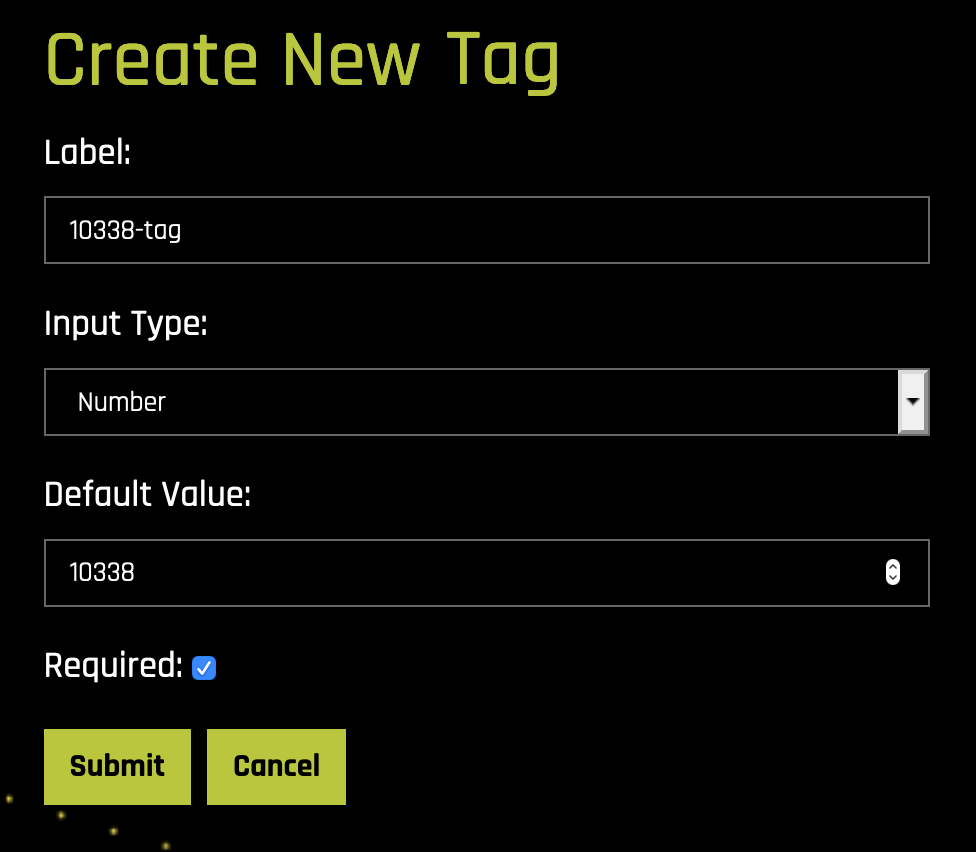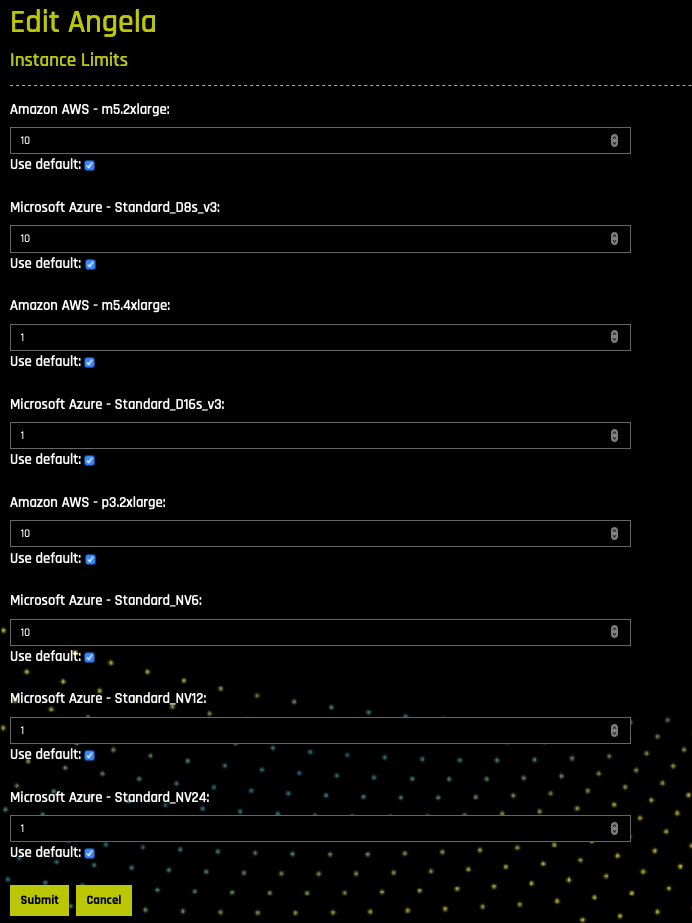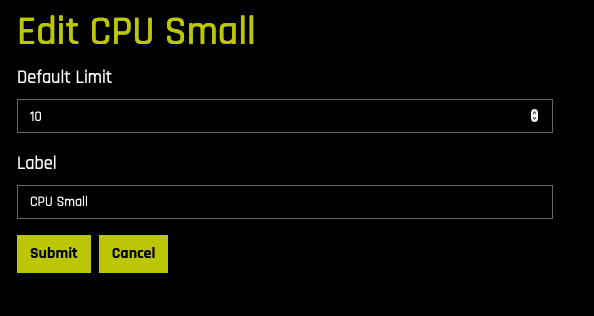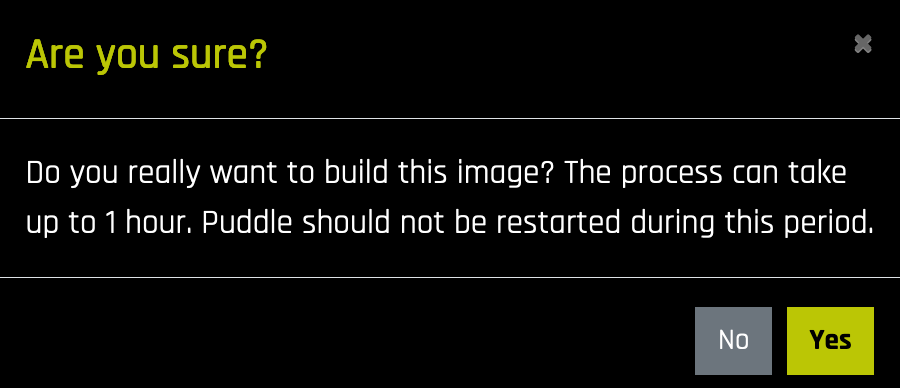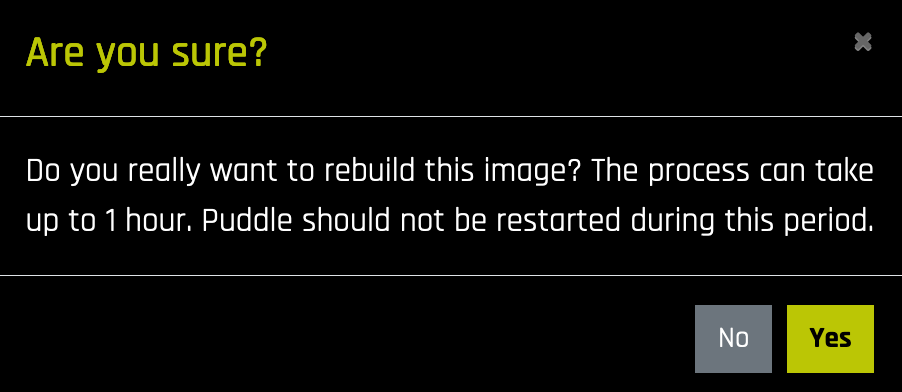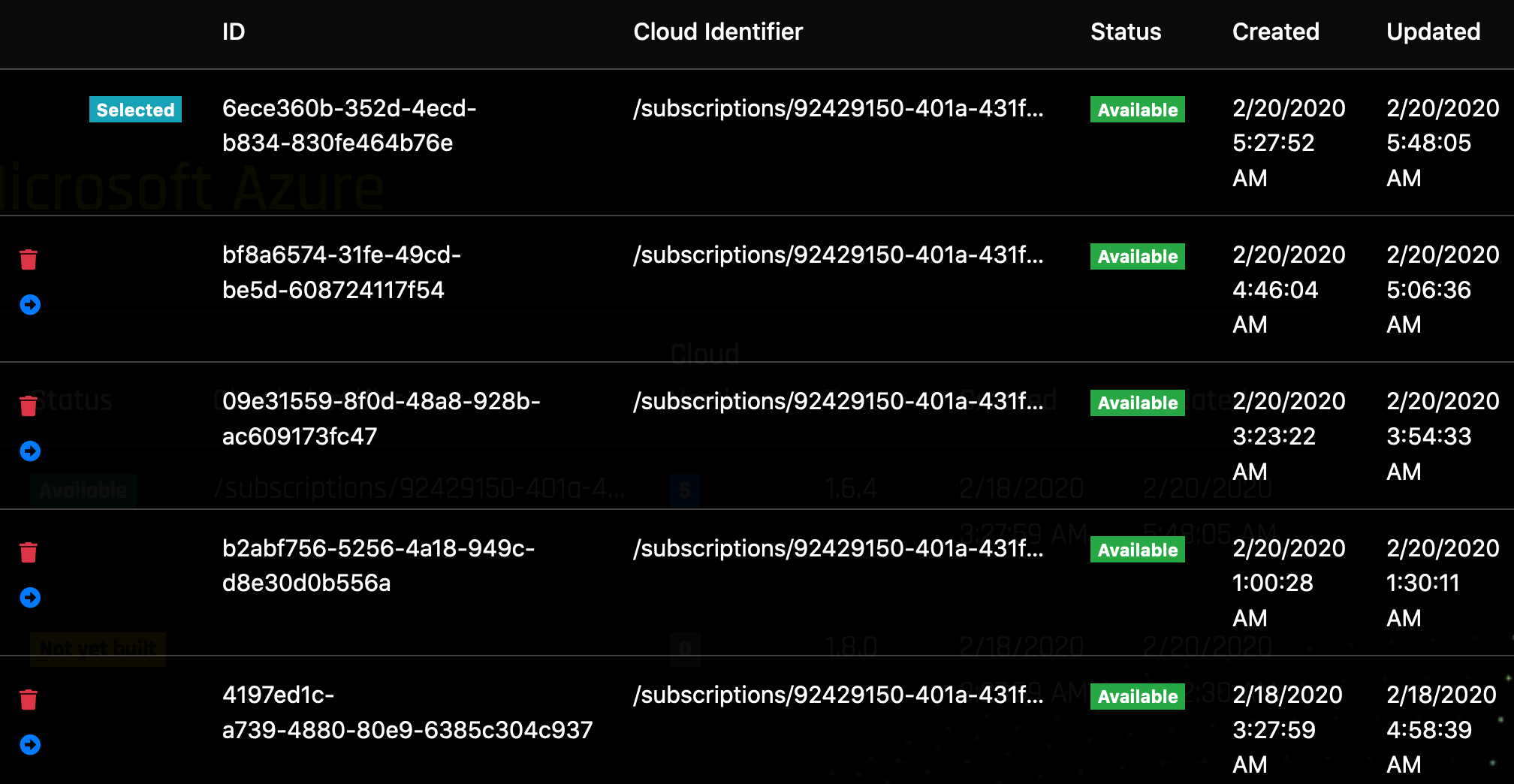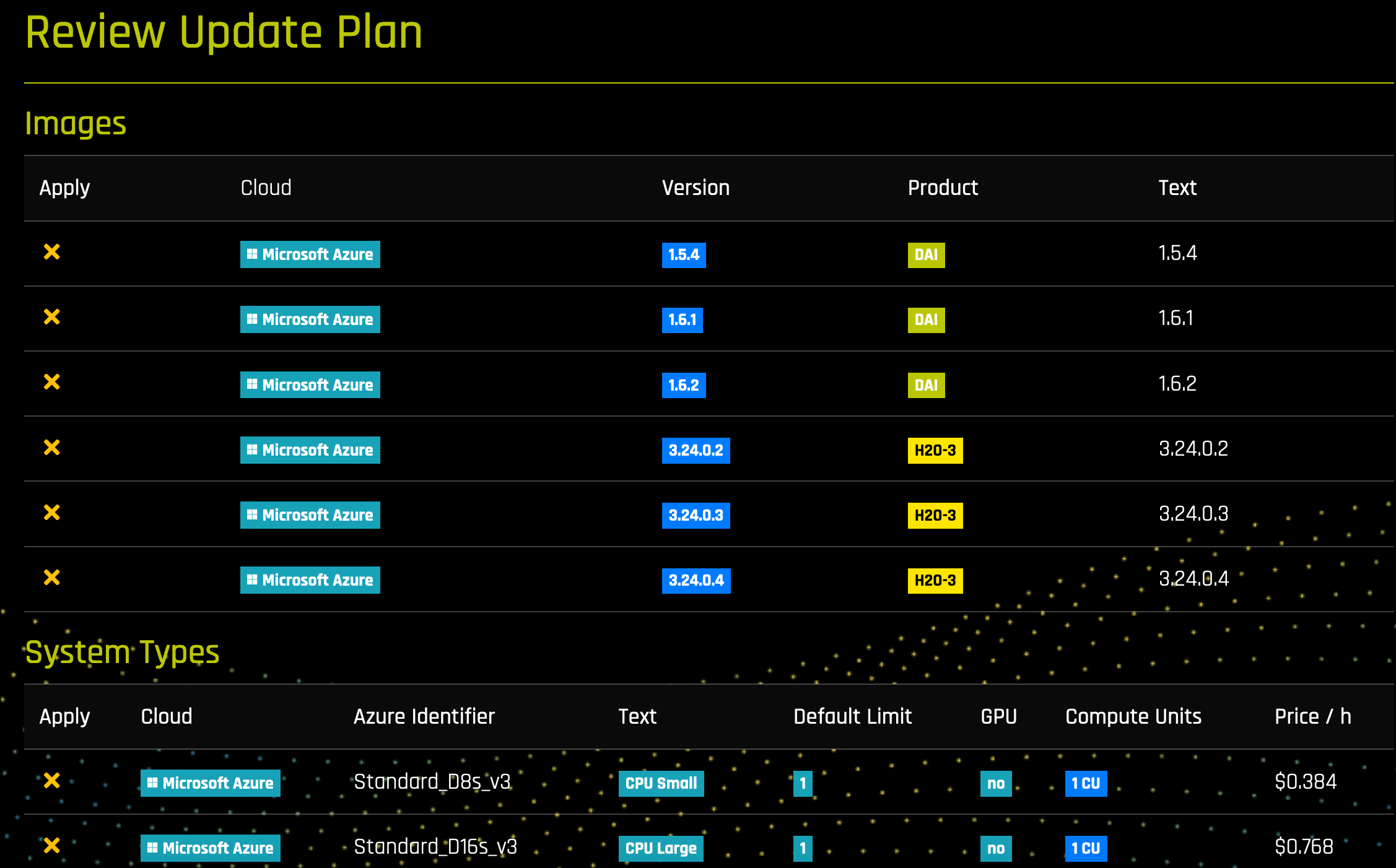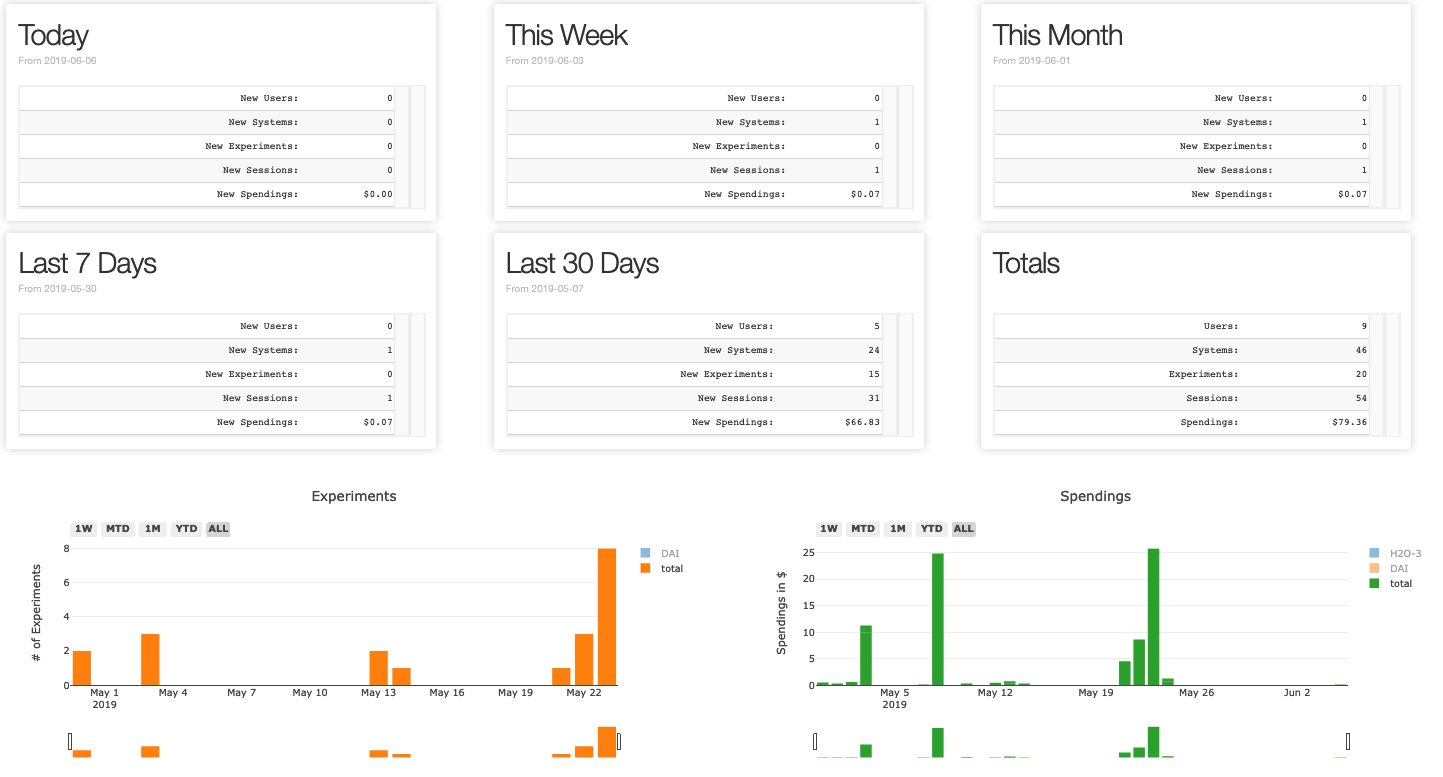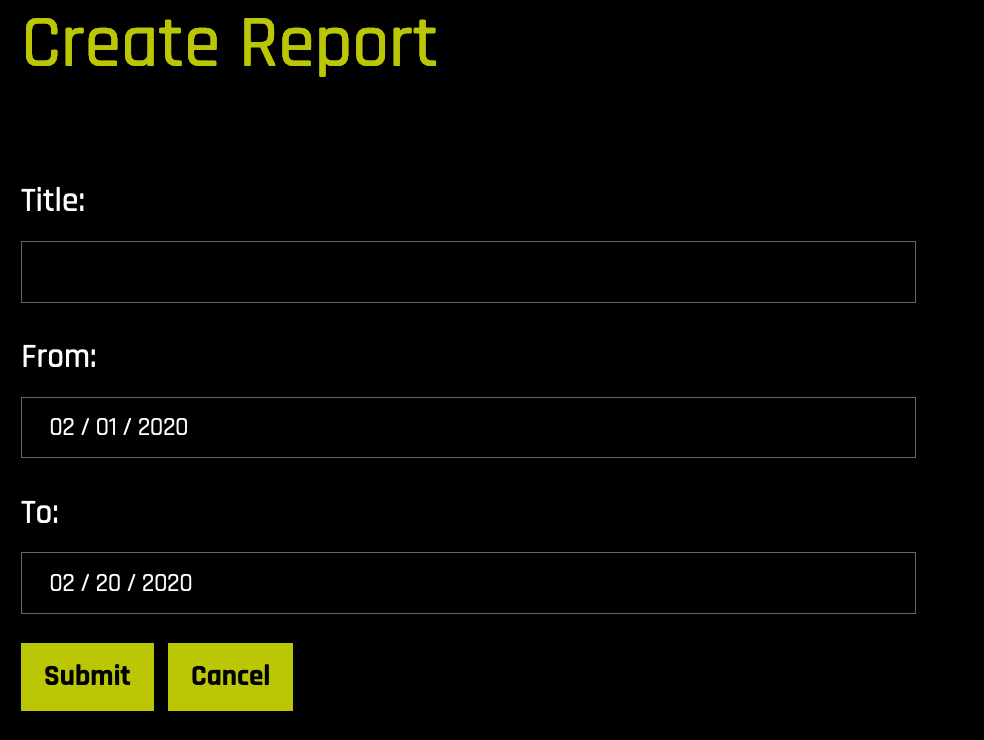Administration¶
Uses with Admin status are provided with an Administrator dropdown menu. From here, Admins can manage systems, experiments, and users. They can also define system types and add new Driveless AI or H2O-3 images. Finally, Admins can also check for Puddle updates and review logs.
Systems¶
The All Systems page lists all systems that have been created in your cloud environment. From here, Admins can start ( ), stop (
), stop ( ), reboot (
), reboot ( ), and destroy (
), and destroy ( ) systems. Admins can also fail (
) systems. Admins can also fail ( ) systems that are provisioning or stopping and can restart Driverless AI instances (
) systems that are provisioning or stopping and can restart Driverless AI instances ( ) without rebooting the entire VM.
) without rebooting the entire VM.
Click on a system name to view a system. The information that displays for each system includes:
- Name
- Owner
- URL
- Cost
- Status
- Type
- Version
- Product
- Cloud
- Created date
You can also click on a URL for a running system to view that system.
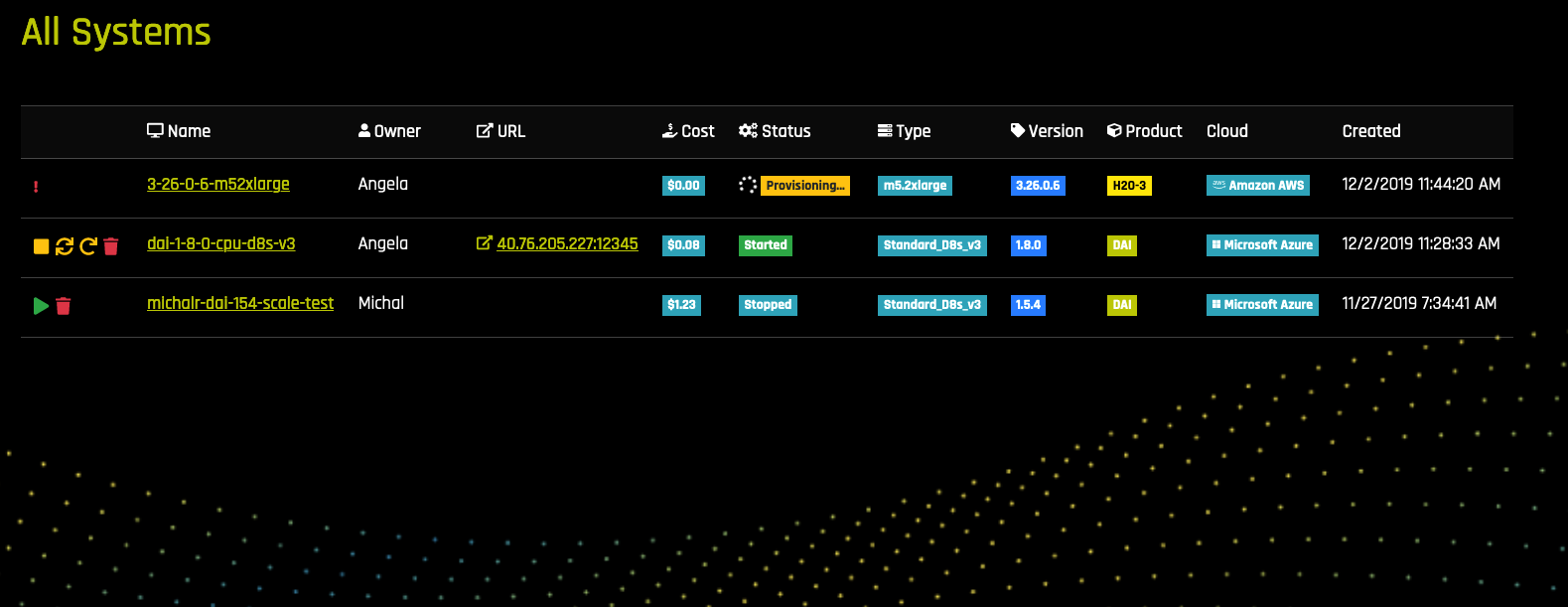
Experiments¶
The All Experiments shows all Driverless AI experiments that have been run through Puddle. The information that displays for each experiments includes:
- System
- User
- Description (experiment name)
- Dataset used for training
- Target column
- Score
- Test Score
- Scorer used in the experiment
- Progress
- Status
- Accuracy setting used in the experiment
- Time setting used in the experiment
- Interprertability setting used in the experiment
- Training Duration
- Creation date and time

Tags¶
Puddle allows Admins to set up tags that can be applied to specific system. The Tags page shows all tags that can be specified when provisioning a new system along with the following information for each tag:
- Label
- Input Type
- Default Value
- Required (Yes or No)
- Date when the tag was created
- Date when the tag was last updated

Creating New Tags¶
Perform the following steps to create a new tag. After new tags are created, they will automatically be available when users create new systems.
- On the Tags page, click the Create New Tag button.
- Specify a label for the tag.
- Specify the tag input type. This can be one of the following:
- Text
- Number
- Date
- Checkbox
- Specify a default value for the input type.
- Specify whether the label is required.
- Click Submit when you are done.
Editing Tags¶
On the Tags page, click the Edit icon ( ) beside the tag that you want to delete. Edit the Input Type, Default Value, and/or Required checkbox, then click Submit to complete the delete. Note that currently tagged systems are not affected when changes are made to tags.
) beside the tag that you want to delete. Edit the Input Type, Default Value, and/or Required checkbox, then click Submit to complete the delete. Note that currently tagged systems are not affected when changes are made to tags.
Deleting Tags¶
On the Tags page, click the Delete icon ( ) beside the tag that you want to delete. A confirmation page will display informing you that current systems will not be affected by this deletion. Click Yes to complete the deletion.
) beside the tag that you want to delete. A confirmation page will display informing you that current systems will not be affected by this deletion. Click Yes to complete the deletion.
Users¶
The All Users page shows all users who have access to Puddle. From this page, Admins can lock users, unlock users, and edit system limits for each user. This page also shows the following for each user:
- Name
- Email address
- Role (Note that this role comes from the user’s appRole in the AD.)
- Status
- Current Spending
- Date when user was added
- Date when user was last updated
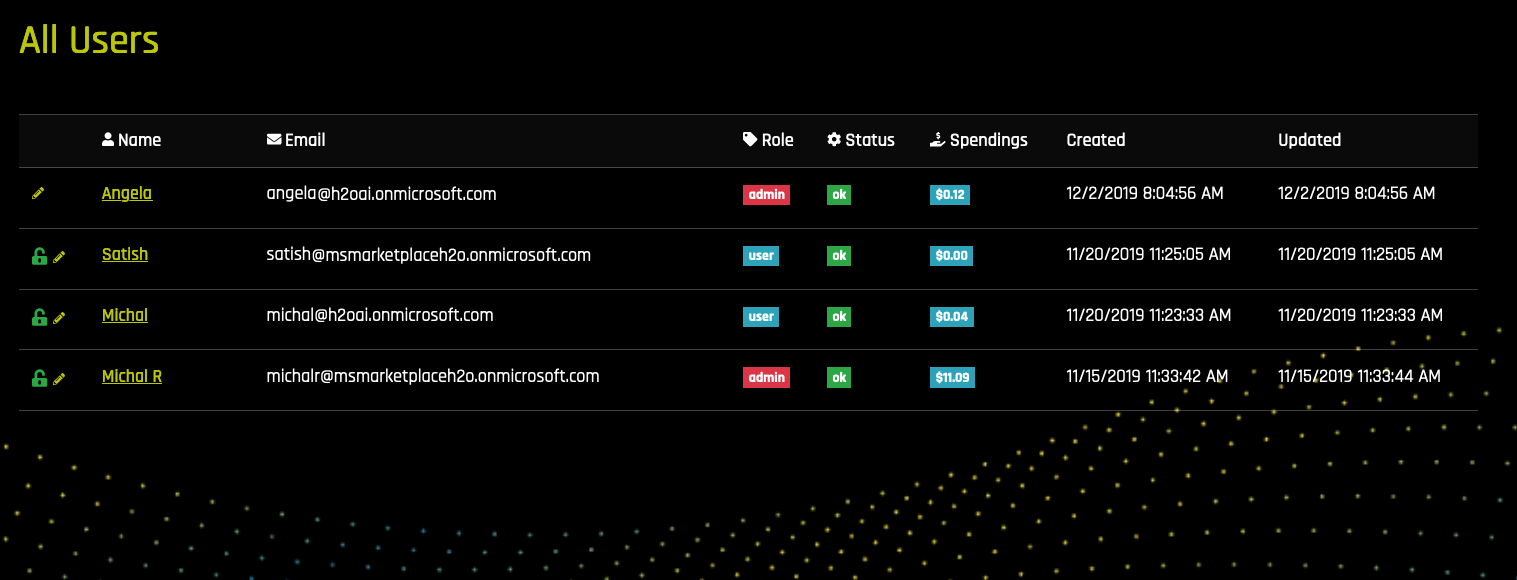
Locking/Unlock Users¶
The Unlock icon ( ) indicates that a user is able to log in to Puddle. Click on this icon to lock that user—locked users will not be able to log in to Puddle. If you lock a user who is currently logged in, that user’s session will be invalidated. The user’s systems, however, will not be deleted. Systems can be deleted manually from the All Systems page. (See Systems.)
) indicates that a user is able to log in to Puddle. Click on this icon to lock that user—locked users will not be able to log in to Puddle. If you lock a user who is currently logged in, that user’s session will be invalidated. The user’s systems, however, will not be deleted. Systems can be deleted manually from the All Systems page. (See Systems.)
The Lock icon ( ) indicates that a user is locked out of Puddle. Click on this icon to unlock that user—unlocked users will be able to log in to Puddle.
) indicates that a user is locked out of Puddle. Click on this icon to unlock that user—unlocked users will be able to log in to Puddle.
Note: Admins cannot lock/unlock themselves. The lock/unlock icons will not be available for the logged in Admin.
Editing User’s Instance Limits¶
Perform the following steps to edit a user’s instance limits. Note that these limits are per system. So, for example, if an m5.4xlarge instance limit is set to 1, then users can create one of either a Driverless AI or an H2O-3 m5.4xlarge system.
Note: The list of available instance types is determined during the Puddle onboarding process. Contact support@h2o.ai if you need to update this list.
- On the All Users page, click the Edit icon (
 ) beside a user to edit instance limits for that user for each system type. On the form that displays, you can specify limits each available instance type.
) beside a user to edit instance limits for that user for each system type. On the form that displays, you can specify limits each available instance type. - Click Submit when you are done or Cancel to leave the form without applying any changes.
System Types¶
The System Types page shows all system types that are available in Puddle for each available cloud environment.

The available types are defined during installation; however, this page allows you lock a system type or edit the default limit and label for a system type. The information that displays on this page includes the following:
- Cloud Identifier
- Default Limit
- Label for the identifier
- Whether the system type is GPU
- Number of Compute Units for the system type
- Price per hour
- Created date
- Updated date
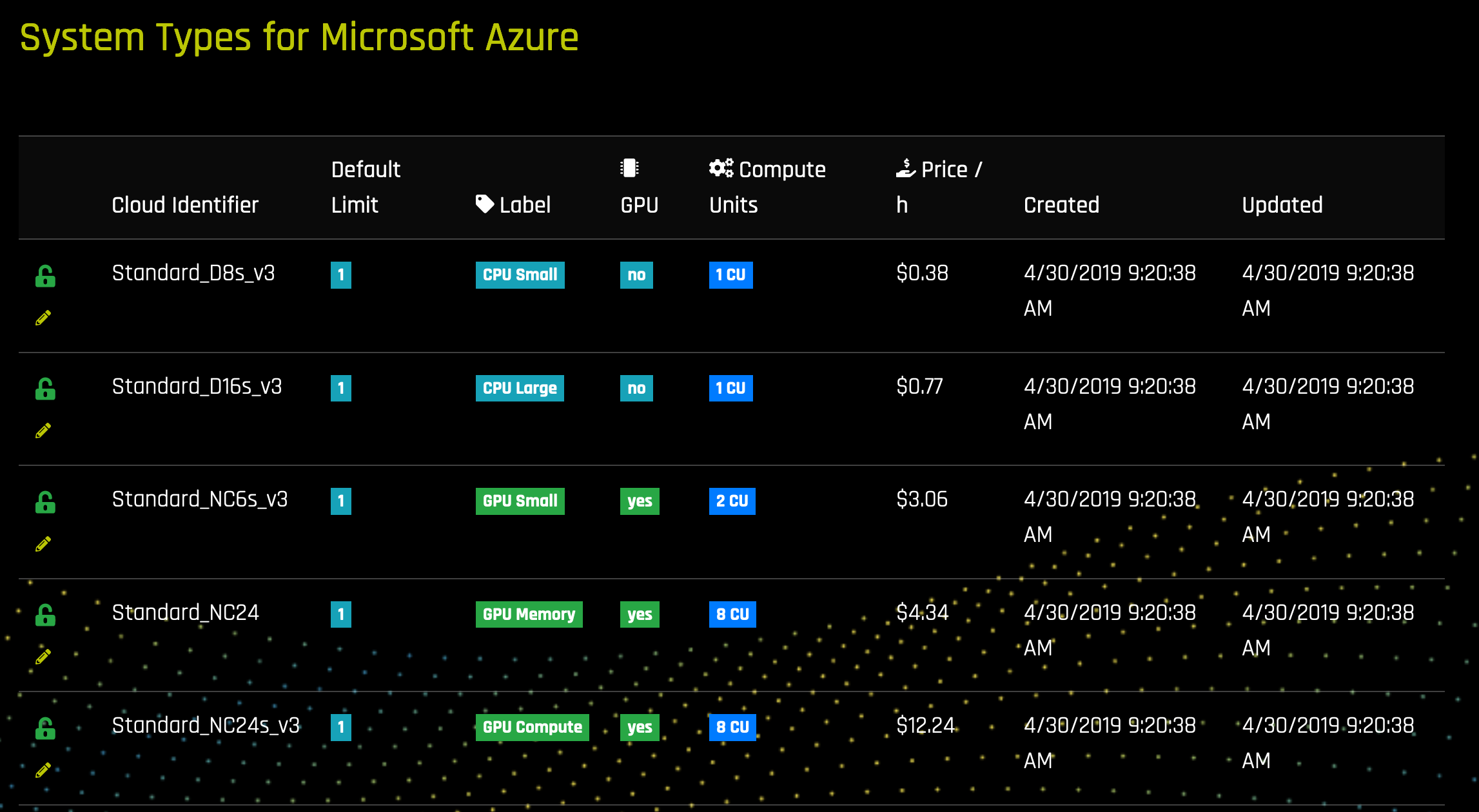
Locking/Unlocking System Types¶
The Unlock icon ( ) indicates that a system type is unlocked. Click on this icon to lock a system type. When it is locked, users will not be able to create new systems with the locked system type. Existing systems with this system type will not be affected.
) indicates that a system type is unlocked. Click on this icon to lock a system type. When it is locked, users will not be able to create new systems with the locked system type. Existing systems with this system type will not be affected.
The Lock icon ( ) indicates that a system type is locked. Click on this icon to unlock a system type. When it is unlocked, users will once again be able to create new systems with the unlocked system type.
) indicates that a system type is locked. Click on this icon to unlock a system type. When it is unlocked, users will once again be able to create new systems with the unlocked system type.
Editing a System Type¶
Click the Edit icon ( ) beside a system type to edit that system’s label and maximum default limit. Click Submit when you are done or Cancel to return the All Systems page without applying any changes.
) beside a system type to edit that system’s label and maximum default limit. Click Submit when you are done or Cancel to return the All Systems page without applying any changes.
Images¶
The Images page shows all Driverless AI and H2O-3 images available for each available cloud environment.

The information that displays on this page for each image includes the following:
- Version
- Product
- Status
- Cloud Identifier
- Cloud Versions
- Text (product version)
- Created date
- Updated date

Locking/Unlocking Images¶
The Unlock icon ( ) indicates that an image is unlocked. Click on this icon to lock an image type. You will be prompted to confirm the request. When it is locked, users will not be able to create new systems with the locked image type. Existing systems with this image type will not be affected.
) indicates that an image is unlocked. Click on this icon to lock an image type. You will be prompted to confirm the request. When it is locked, users will not be able to create new systems with the locked image type. Existing systems with this image type will not be affected.
The Lock icon ( ) indicates that an image is locked. Click on this icon to unlock an image type. You will be prompted to confirm the request. When it is unlocked, users will once again be able to create new systems with the unlocked image type.
) indicates that an image is locked. Click on this icon to unlock an image type. You will be prompted to confirm the request. When it is unlocked, users will once again be able to create new systems with the unlocked image type.
Building Images¶
Click the Build Image ( ) icon to start building an image. You will be prompted to confirm the request. The build process can take up to an hour. Do not restart Puddle when building an image.
) icon to start building an image. You will be prompted to confirm the request. The build process can take up to an hour. Do not restart Puddle when building an image.
Rebuilding Images¶
Puddle allows you to build multiple images for a specific product and version. Click the Rebuild icon ( ) to rebuild an image. You will be prompted to confirm the request. The rebuild process can take up to an hour. Do not restart Puddle when rebuilding an image. Upon completion, the Cloud Versions column will update to show that there are now multiple versions of this image.
) to rebuild an image. You will be prompted to confirm the request. The rebuild process can take up to an hour. Do not restart Puddle when rebuilding an image. Upon completion, the Cloud Versions column will update to show that there are now multiple versions of this image.
Deleting Images¶
Click the Delete icon ( ) beside a locked image to delete that image. Note that unlocked images cannot be deleted.
) beside a locked image to delete that image. Note that unlocked images cannot be deleted.
Cloud Versions¶
As indicated previously, Puddle allows you to build/rebuild multiple images for a specific product and version. The Cloud Versions column shows the number of versions currently available. Click on the number icon in the Cloud Versions column to view a list of all available cloud versions.

For each image, the Cloud Versions table shows the ID, the cloud identifier, the status, and the created and updated dates. This table also shows the Selected version (version currently in use). Click the Use this version icon ( ) to select a different version. Or you can click the Delete icon (
) to select a different version. Or you can click the Delete icon ( ) to delete a version. Note that you cannot delete the Selected version.
) to delete a version. Note that you cannot delete the Selected version.
Edit config.toml¶
The Edit config.toml page allows you to specify environment-wide configuration options for all Driverless AI systems. Note that when you make edits to this config.toml, existing systems are not affected and will have to be updated manually.
A list of all available config.toml options is available in the Driverless AI User Guide. Note that this points to the latest-stable version of the config.toml. Refer to the Driverless AI Prior Releases page to view documentation for a specific version of Driverless AI.

Check Updates¶
The Check for Updates page allows you to verify whether you have the latest version of Puddle.
- Specify the URL for your Puddle image or click Browse to locate an image on your local machine.
Click Submit when you are done. After the image is located, the Review Update Plan page displays. This page shows images and system types that are available on your Puddle.
Review the images and system types that are available.
Note: If desired, you can delete any of the available images or system types from this page.
Click Apply to apply the update or Cancel to cancel the request.
Stats Board¶
The Stats Board provides admins with detailed information about the number of new users, systems, experiments, sessions, and money spent for the current day, current week, current month, last 7 days, last 30 days, and overall.
The lower section of the page includes interactive Plotly charts for the number of Experiments and Spending totals (in US dollars) on your system.
Reports¶
The Reports page allows you to create and view reports detailing information about Puddle usage in your environment over a specified date range. Click the Download icon ( ) beside a report to download that report’s CSV file. This file includes the following:
) beside a report to download that report’s CSV file. This file includes the following:
- jobs.csv: This report provides detailed information about jobs that have been run in your Puddle environment.
- sessions.csv: This report provides detailed information about systems being run in your Puddle environment.

Create Report¶
You can create reports to view information about Puddle usage for specific time ranges. On the Reports page, pick the Create Report button. Specify a name and date range for the report, then click Submit to run the report.
About¶
The About page provides the curent build information including the Puddle version, build number, git commit, build time, built by system, and built on system.

